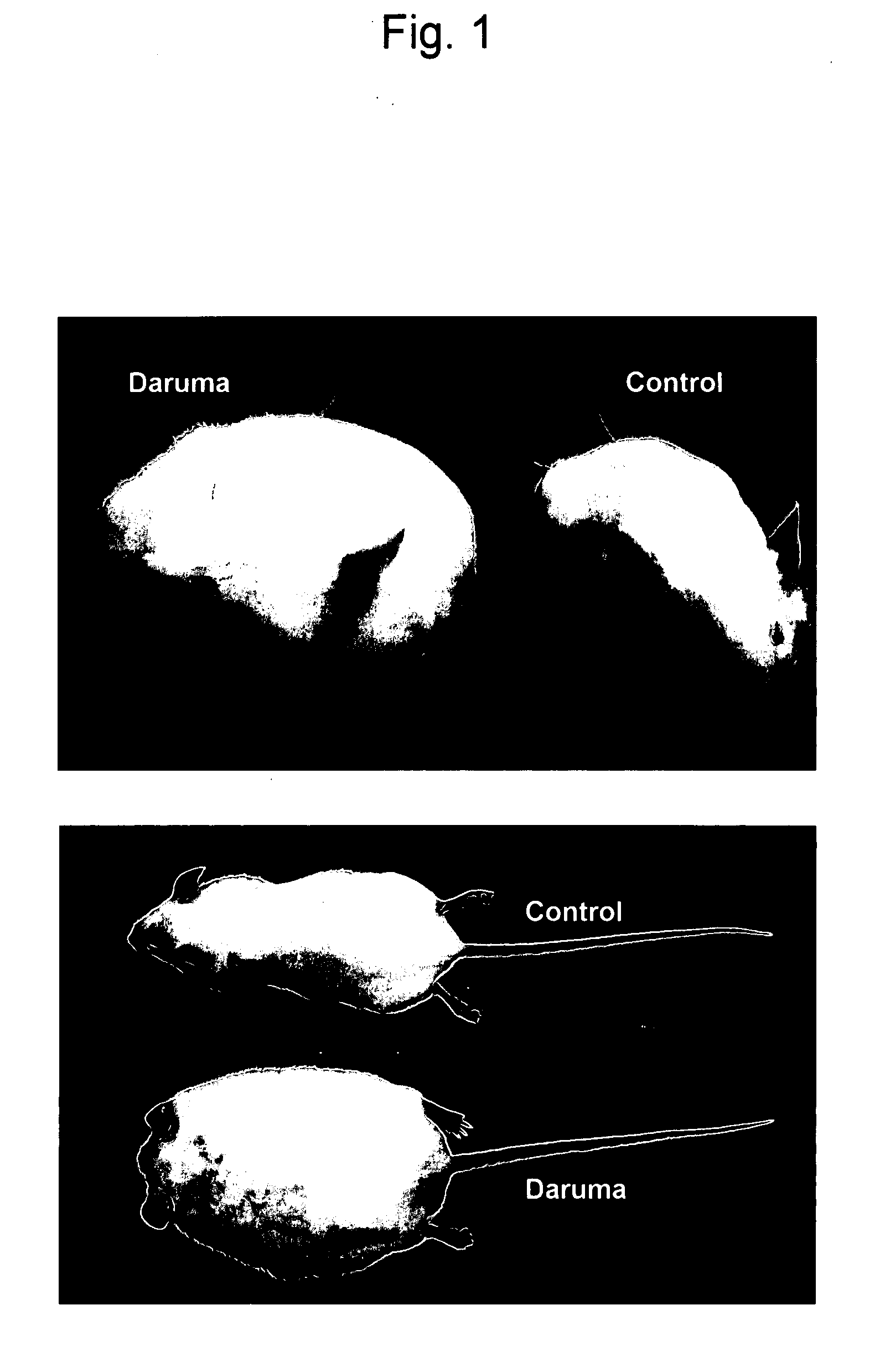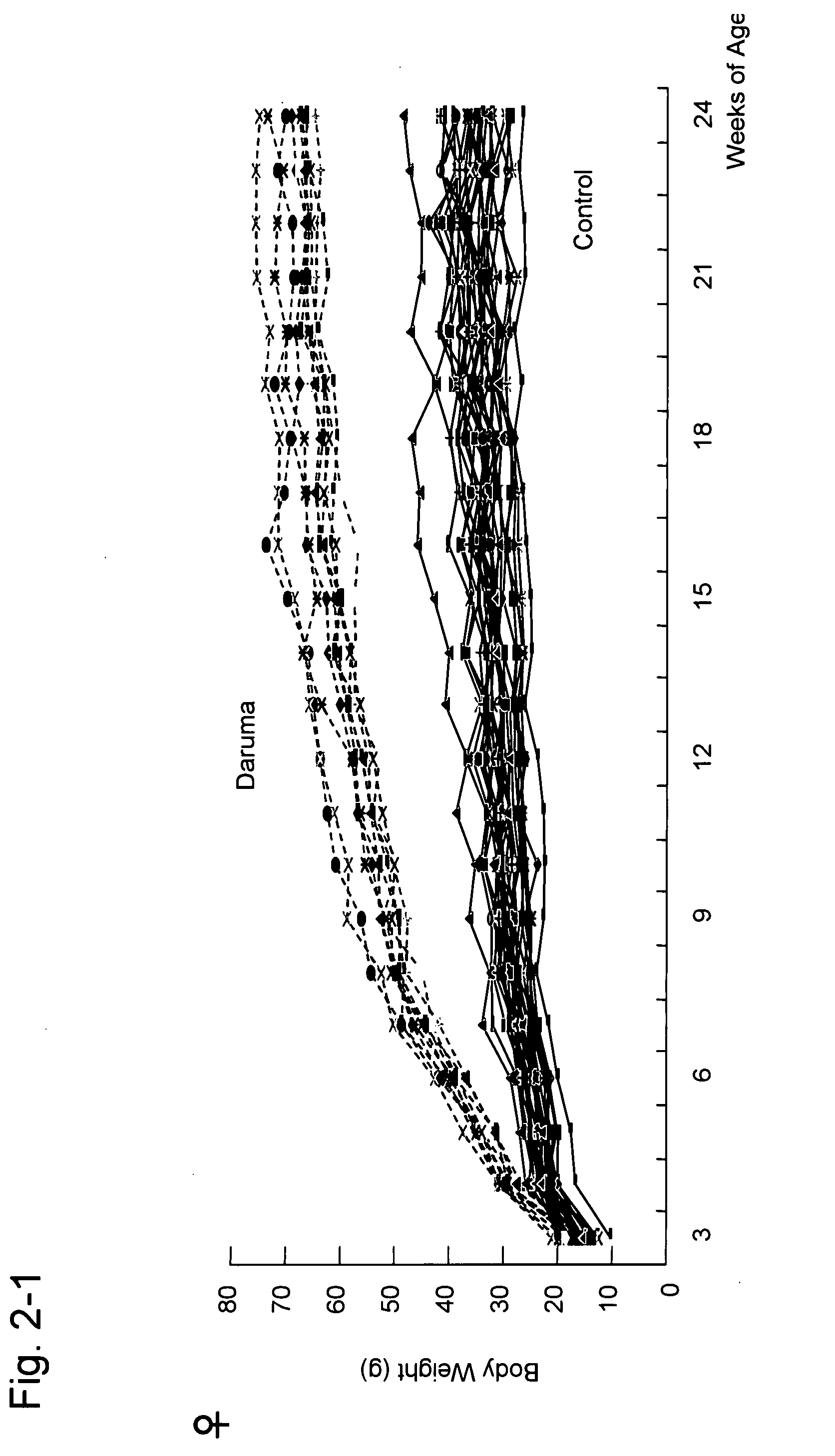Mouse developing visceral fat type obesity and diabetes
a visceral fat type and obesity technology, applied in the field of mice, can solve the problems of long time for mice to develop obesity or diabetes, and show a significant degree of obesity, and achieve the effect of intense visceral fat type obesity
- Summary
- Abstract
- Description
- Claims
- Application Information
AI Technical Summary
Benefits of technology
Problems solved by technology
Method used
Image
Examples
example 1
Establishment of the Obesity Mouse Strain Daruma
[0109]Two mice having obesity were discovered in 2005 among ICR mice maintained in the Laboratory of Veterinary Physiology, Department of Veterinary Medicine, Faculty of Agriculture, Miyazaki University. Suspecting the possibility that the obesity had been caused by gene mutation, we performed the following experiment. The mice having obesity were subjected to back crossing. As a result, some of their children developed obesity. Accordingly, speculating that a problem was present on gene, we purchased wild ICR mice from Charles River Laboratories Japan, Inc. to cross with the obese mice. Consequently, no F1 mice developed obesity; however, obesity occurred at an incidence rate of about 25% when the F1 mice were crossed with each other. Subsequently, when these obese mice were crossed with each other, the resultant mice were all obese. In addition, a cross was repeated between the wild and obese mice, between the heterozygous mice, and ...
example 2
Comparison of Physiological and Biochemical Characteristics Between Obese Daruma Mice and Conventional Mice
[0110](1) Comparison of Appearance
[0111]FIG. 1 shows a comparison of appearance between obese Daruma mice and conventional mice. The obese mice and conventional mice were each born from the same parent. As depicted in the figure, the obese Daruma mice featured visceral fat type barrel obesity.
[0112](2) Comparison of Growth Curves
[0113]The body weight of obese Daruma mice and conventional mice was measured from 3 to 24 weeks of age. Ten each of males and females were used for both of the obese Daruma and conventional mice. FIG. 2 shows growth curves thereof. FIG. 2-1 shows growth curves of the females, and FIG. 2-2 shows those of the males. A body weight difference occurred between the females of both strains of mice from 4 weeks of age and between the males thereof from 6 weeks of age; twice as much body weight difference occurred from 15 weeks of age on. These differences were...
example 3
Comparison with Other Obese Mice
Comparison of the Body Weight Gains and a Crossing Experiment
[0132]When growth curves were prepared, it was found that the male and female Daruma mice started to show obesity from about 4 to 5 weeks of age after weaning and had a body weight of 1.5 times that of the control mice at 15 weeks of age and of about 2 times thereof at 20 weeks of age. When the time at which the Daruma mice started to show obesity was compared with that at which other model mice did, the time was late (about 6 to 8 weeks of age) in fat (fat) mice and (9 to 12 weeks of age) in tubby (tub) mice; obeseb (ob) and diabetes (db) mice started to become obese at an early stage of about 4 to 5 weeks of age. Thus, the obesity onset time in the Daruma mice was similar to those in the obese (ob) and diabetes (db) mice. Comparison of only the body weight increase rates showed that the body weight increase profile of the Daruma mice was similar to, rather than those of the obese (ob), dia...
PUM
| Property | Measurement | Unit |
|---|---|---|
| Time | aaaaa | aaaaa |
| Strain point | aaaaa | aaaaa |
Abstract
Description
Claims
Application Information
 Login to View More
Login to View More - R&D
- Intellectual Property
- Life Sciences
- Materials
- Tech Scout
- Unparalleled Data Quality
- Higher Quality Content
- 60% Fewer Hallucinations
Browse by: Latest US Patents, China's latest patents, Technical Efficacy Thesaurus, Application Domain, Technology Topic, Popular Technical Reports.
© 2025 PatSnap. All rights reserved.Legal|Privacy policy|Modern Slavery Act Transparency Statement|Sitemap|About US| Contact US: help@patsnap.com



